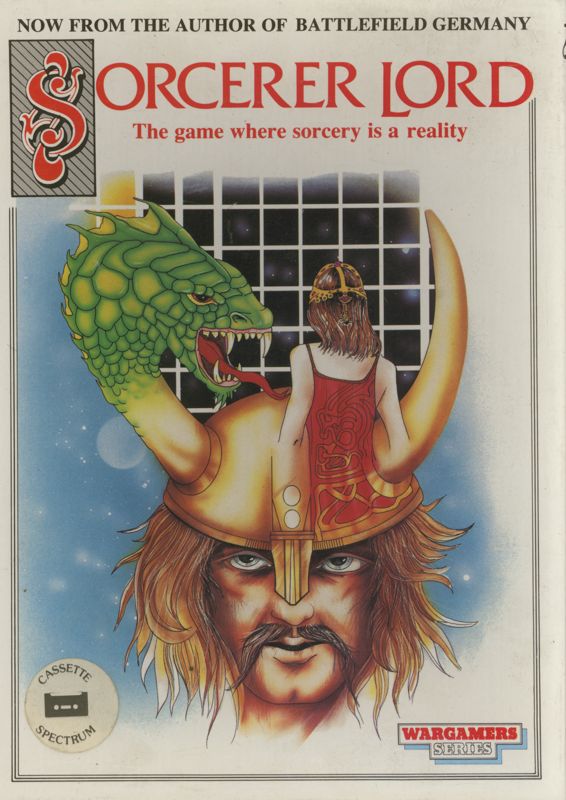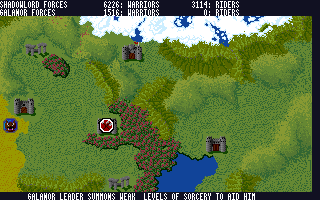Retro Replay Review
Gameplay
Sorcerer Lord offers a classic turn-based tactical experience set on a 2D hexagonal map, where every move counts. Players alternate turns with the Shadowlord, recruiting new units, shifting armies across varied terrain, and attempting to seize enemy garrisons. The core mechanics are straightforward, but beneath the surface lies a satisfying layer of strategy that requires careful attention to positioning, unit strengths, and the looming turn limit.
(HEY YOU!! We hope you enjoy! We try not to run ads. So basically, this is a very expensive hobby running this site. Please consider joining us for updates, forums, and more. Network w/ us to make some cash or friends while retro gaming, and you can win some free retro games for posting. Okay, carry on 👍)
Each race in Galanor brings unique advantages: elves are agile in forests, dwarves stand their ground in mountains, and humans hold firm on plains. Balancing these strengths against enemy compositions and terrain is essential. Fatigue levels influence how far your armies can march and how well they perform in combat, encouraging players to rotate troops or risk pushing tired units into dangerous engagements. While the combat resolution is presented purely in text, the concise battle reports relay detailed outcomes—casualties, leader performance, and morale shifts—that drive your next decision.
Magic in Sorcerer Lord lives up to its name more in spirit than in function. Rather than casting grand spells at will, players encounter magical effects as random battle modifiers—lightning strikes, sudden mist, or momentary stuns—that can tip the scales but never fully replace sound strategy. To heighten the urgency, a strict turn limit forces you to advance the front or risk defeat by exhaustion of time. On Easy difficulty you get 40 turns; on higher levels, the clock ticks even faster, demanding decisive, well-planned offensives.
Graphics
Visually, Sorcerer Lord embraces a retro aesthetic reminiscent of early PC strategy titles. The 2D hex grid is rendered with clear, easily distinguishable terrain icons—forests rich in green, snow-capped mountains, rolling plains, and winding rivers. While the detail level is modest by modern standards, it serves the gameplay perfectly, ensuring that no confusion arises about movement costs or defensive bonuses tied to each hex.
Army units appear as simple yet evocative counters: a mounted knight silhouette for cavaliers, a stout axe-wielding figure for dwarves, and a slender archer for elves. Though there are no animated skirmishes or flashy spell effects, the user interface supplies tooltips and text readouts that keep you informed on unit stats, leader attributes, and upcoming fatigue penalties. This no-frills presentation prioritizes clarity and speed, allowing veteran tacticians to focus on big-picture maneuvers without long load times or distracting animations.
The strategic map’s color palette strikes a balance between readability and immersion. Neutral zones are shaded in soft earth tones, while enemy-controlled regions glow in ominous reds. Subtle border highlights and blinking icons mark areas under threat or ready for recruitment. Although Sorcerer Lord won’t win awards for high-definition visuals, its stripped-down artistry feels purposeful, channeling your concentration squarely onto strategy rather than spectacle.
Story
The narrative of Sorcerer Lord is elegantly concise: the malevolent Shadowlord marshals dark forces to crush the free races of Galanor, and you must unite disparate allies to stave off tyranny. This straightforward premise sets the stage for a grand war without bogging you down in lengthy dialogue trees or branching plot arcs. Each turn of the campaign advances the map’s situation, echoing the growing tension between hope and subjugation.
While there are no voiced cutscenes or illustrated story sequences, in-game text briefs provide context before each campaign. You learn of the Shadowlord’s next target, the morale of your armies, and the state of alliances among humans, elves, dwarves, and other races. This minimalist approach leaves room for player imagination, as you mentally craft the heroics, betrayals, and legends that unfold on the hex grid.
Though fans of deep, character-driven narratives might find the plot skeletal, it excels as a backdrop for methodical warfare. The simplicity of the story ensures that players remain focused on tactical choices rather than intricate lore. In this way, Sorcerer Lord’s narrative functions as a rallying cry, urging you to marshal your forces and defend Galanor against the encroaching darkness.
Overall Experience
Sorcerer Lord delivers a pure, time-tested formula of turn-based tactical warfare with a medieval fantasy veneer. Its low-tech presentation is offset by robust strategic depth: terrain advantages, unit fatigue, recruitment timing, and a looming turn limit all intertwine to create a compelling challenge. Whether you’re a veteran of hex-and-counter wargames or a newcomer seeking a manageable entry point, the game’s clear mechanics warmly welcome all.
Patience and foresight are rewarded: players who study enemy movements, leverage racial strengths, and maintain supply lines will find themselves steadily pushing the Shadowlord back. Occasional bursts of magical chaos add unpredictability, ensuring that no two campaigns play out the same. While the lack of dynamic storytelling or high-end visuals may disappoint some, those qualities allow the gameplay to shine unimpeded.
In sum, Sorcerer Lord stands as an exemplar of old-school tactical design—simple to learn, hard to master, and deeply satisfying for strategy enthusiasts. If you crave a bite-sized, intellectually stimulating war game that emphasizes planning over spectacle, rally your allies in Galanor and prove yourself worthy of the title “Sorcerer Lord.”
 Retro Replay Retro Replay gaming reviews, news, emulation, geek stuff and more!
Retro Replay Retro Replay gaming reviews, news, emulation, geek stuff and more!









Reviews
There are no reviews yet.